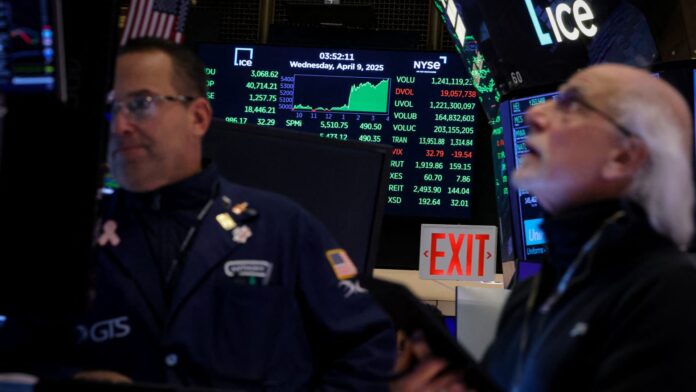Traders work on the floor at the New York Stock Exchange on April 9, 2025.
Brendan McDermid | Reuters
S&P 500 futures fell on Thursday morning after President Donald Trump announced a 90-day reprieve on some of his “reciprocal” tariffs, spurring a massive rally on Wall Street.
Futures tied to the S&P 500 were 0.66% fell, while Nasdaq-100 futures traded up 1.2%. Dow Jones Industrial Average futures lost 108 points, or about 0.3%.
The moves come after a historic surge on the Street, where the S&P 500 soared more than 9% during Wednesday’s session to see its third-largest gain in a single day since World War II. The Dow Jones Industrial Average also saw its biggest percentage advance since March 2020, while the Nasdaq Composite scored its biggest one-day gain since January 2001 and second-best day on record.
During Wednesday’s session, there was an unusual trading volume of around 30 billion shares, the highest level in history, as per records dating back 18 years.
The rally took off after Trump announced a temporary drop in tariff rates for most countries to 10% for 90 days. Canada and Mexico won’t be subjected to an additional 10% duty, however.
“I thought that people were jumping a little bit out of line,” Trump said. “They were getting yippy, you know, they were getting a little bit yippy, a little bit afraid.”
To be sure, that still leaves this 125% rate on goods from China. Trump said that he thinks the U.S. and China will end up making a “very good deal.”
Despite optimism in response to the 90-day reprieve, some on the Street are skeptical that we may not be out of the woods just yet.
“I think you need certainty,” Mohamed El-Erian, Allianz’s chief economic advisor, said Wednesday on CNBC’s “Closing Bell.” “I think the 90 days, that’s a good period, but quickly people are going to start asking what happens next.”
Others were echoing a similar sentiment amid the market surge, with LPL Financial’s Jeffrey Roach still calling for the potential of more turmoil ahead.
“Market volatility could remain elevated, despite the 90-day pause on tariffs for non-retaliating countries,” said Roach, chief economist at LPL Financial. “Hard data from the early part of the year suggests the economy is slowing, irrespective of trade policy.”
On the economic front, traders are looking ahead to March’s consumer price index reading and weekly jobless claims, due out Thursday before the opening bell. Producer price index data for March will be out on Friday morning.
